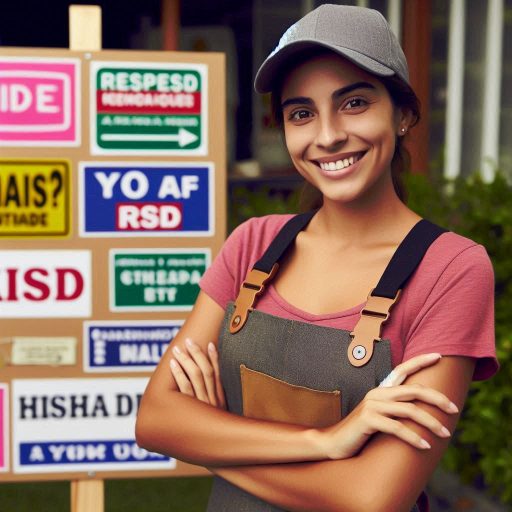Introduction
Creating captivating and effective signage requires more than just technical skills.
Artistic inspirations play a crucial role in helping sign makers to craft unique and engaging designs that stand out in a crowded marketplace.
Importance of artistic inspirations
Artistic inspirations provide sign makers with fresh ideas, creativity, and a unique perspective that can help them create visually stunning and memorable signage.
By drawing inspiration from various sources, sign makers can infuse their designs with creativity and innovation.
Sources of inspiration for sign makers
- Nature: The beauty and symmetry found in nature can inspire color palettes, textures, and organic shapes for signage designs.
- Art movements: Studying different art movements such as Art Deco, Pop Art, or Minimalism can provide sign makers with inspiration for unique styles and design elements.
- Architecture: The lines, patterns, and structural elements of buildings can spark ideas for signage layouts and compositions.
- Typography: Exploring different fonts, letterforms, and typographic styles can inspire creative approaches to designing text-based signage.
- Cultural influences: Drawing inspiration from diverse cultures, traditions, and historical references can add depth and meaning to signage designs.
By tapping into these diverse sources of inspiration, sign makers can expand their creative horizons, experiment with new techniques, and ultimately, produce signage that not only communicates effectively but also resonates with their audience on a deeper level.
Nature-inspired Designs
How nature can serve as a great source of inspiration for sign makers
Nature is a limitless well of inspiration for sign makers, offering a plethora of unique and beautiful elements to incorporate into their designs.
Examples of how elements like flowers, trees, and animals can be incorporated into sign designs
- Flowers: By using the intricate shapes and vibrant colors of flowers, sign makers can create eye-catching and elegant designs.
- Trees: The majestic beauty and organic lines of trees can add a sense of strength and growth to a sign design.
- Animals: Animals have long been symbols of different qualities and characteristics, making them great inspirations for sign makers.
By capturing the essence of nature in their designs, sign makers can create visually stunning and meaningful signs that resonate with viewers.
Whether it’s a delicate floral motif, a strong tree silhouette, or a playful animal character, nature-inspired designs can bring a sense of beauty and harmony to any sign.
Read: The Role of Sign Makers in Branding
Vintage and Retro Aesthetics
When it comes to sign making, vintage and retro aesthetics have gained immense popularity in recent years.
These designs harken back to earlier decades, creating a sense of nostalgia and charm that resonates with customers.
Sign makers can draw inspiration from past eras to create timeless and appealing signs that stand out from the crowd.
Popularity of Vintage and Retro Designs
- Vintage and retro designs evoke feelings of nostalgia and familiarity.
- Customers are drawn to the unique charm and character of vintage signs.
- These designs can help businesses create a memorable and distinctive brand image.
- Sign makers can tap into the emotional connection that customers have with vintage aesthetics.
How Sign Makers Can Draw Inspiration from Past Eras
- Study design elements from different eras such as the 1950s, 60s, or 70s.
- Experiment with retro color palettes like mustard yellow, avocado green, and burnt orange.
- Incorporate vintage typography styles such as Art Deco or Mid-Century Modern fonts.
- Use distressed textures and weathered finishes to give signs an aged look.
By incorporating vintage and retro aesthetics into their designs, sign makers can create visually stunning signs that resonate with customers on a deep emotional level.
These timeless designs have a nostalgic appeal that can help businesses stand out in a crowded marketplace.
Whether it’s a classic diner sign or a retro-inspired storefront, vintage and retro aesthetics offer endless possibilities for sign makers to showcase their creativity and craftsmanship.
Read: Eco-Friendly Materials for Sign Making
Typography and Calligraphy
Typography and calligraphy are essential elements in sign making as they play a crucial role in conveying the message effectively.
Significance of Typography and Calligraphy
Typography is the style and appearance of printed matter, while calligraphy is the art of beautiful writing.
They help in creating visually appealing and easy-to-read signs that grab attention.
Choosing the right typography and calligraphy can evoke emotions and set the tone for the message.
Transform Your Career Today
Unlock a personalized career strategy that drives real results. Get tailored advice and a roadmap designed just for you.
Start NowThey add personality and uniqueness to signs, making them stand out from the crowd.
Typography and calligraphy can enhance the overall design aesthetic of a sign and make it more memorable.
Experimenting with Different Fonts and Styles
Sign makers can experiment with various fonts to find the perfect style that suits the message and brand.
Using a mix of serif, sans-serif, script, and display fonts can create visual interest and hierarchy in the design.
Combining different styles such as bold, italic, and underlined text can help emphasize key points and make them stand out.
Play around with letter spacing, sizing, and alignment to achieve a balanced and harmonious composition.
Explore custom lettering and hand-drawn calligraphy to add a personal touch and craftsmanship to the signs.
Tips for Enhancing Designs with Typography and Calligraphy
- Match the typography and calligraphy style to the overall theme and purpose of the sign.
- Consider the legibility of the text by choosing fonts that are clear and easy to read from a distance.
- Use hierarchy in typography to guide the viewer’s eyes and prioritize information based on importance.
- Experiment with color combinations to create contrast and make the text pop against the background.
- Don’t be afraid to break conventional rules and try unconventional typography and calligraphy styles to make a statement.
In essence, typography and calligraphy are key artistic inspirations for sign makers to create compelling and visually appealing designs.
By experimenting with different fonts and styles, sign makers can elevate their work and effectively communicate their message to the audience.
Abstract and Geometric Patterns
When it comes to creating unique and eye-catching signs, sign makers can draw inspiration from abstract and geometric patterns.
These patterns can add a modern and sophisticated touch to any sign, making it stand out from the crowd.
Here are some ways sign makers can incorporate abstract and geometric patterns into their designs:
Experimenting with Shapes
Using geometric shapes such as squares, triangles, circles, and hexagons can create a sense of order and structure in a sign design.
Playing with different shapes can help sign makers add visual interest and create a dynamic composition.
Playing with Lines
Lines can be used to create movement, depth, and texture in a sign design.
Sign makers can experiment with different types of lines, such as straight, curved, or zigzag lines, to convey a particular mood or atmosphere in their designs.
Using Bold Colors
Color plays a crucial role in sign making, and using bold and vibrant colors can make a sign visually striking and memorable.
Sign makers can experiment with different color combinations to create a harmonious and visually appealing design.
Creating Contrast
Contrast is essential in creating visually appealing signs, and sign makers can use abstract and geometric patterns to create contrast in their designs.
Contrasting shapes, lines, and colors can help certain elements stand out and grab the viewer’s attention.
Transform Your Career Today
Unlock a personalized career strategy that drives real results. Get tailored advice and a roadmap designed just for you.
Start NowIncorporating Negative Space
Negative space, the empty space around and between design elements, is just as crucial as the elements themselves.
Sign makers can use negative space to create balance and harmony in their designs, allowing the patterns to breathe and stand out.
Overall, abstract and geometric patterns offer endless possibilities for sign makers to create visually stunning and eye-catching designs.
By experimenting with shapes, lines, colors, contrast, and negative space, sign makers can elevate their signs to a whole new level of artistic expression.
Read: Graphic Design Software for Sign Makers

Cultural Influences
Incorporating cultural elements adds depth and meaning to sign designs.
Sign makers can draw inspiration from different cultures to create inclusive and meaningful signs.
Importance of Cultural Elements
Incorporating cultural elements into sign designs is crucial for creating a connection with the audience.
Culture plays a significant role in shaping our identities, values, and beliefs.
By incorporating cultural elements into sign designs, sign makers can evoke emotions, spark conversations, and create a sense of belonging for individuals from diverse backgrounds.
Ways to Draw Inspiration
Sign makers can draw inspiration from different cultures in various ways:
- Study Cultural Symbols: Research and understand the symbols, motifs, and colors that are significant in different cultures.
Incorporate these elements tastefully into sign designs. - Local Cultural Events: Attend cultural events, festivals, and exhibitions to immerse yourself in different cultures.
Observe the art, architecture, and traditions unique to each culture. - Collaborate with Cultural Experts: Work with individuals from diverse cultural backgrounds to gain insights and perspectives on how to incorporate cultural elements respectfully and authentically.
- Travel and Explore: Travel to different countries and regions to experience firsthand the art, architecture, and traditions of various cultures.
Use these experiences to inspire your sign designs. - Community Involvement: Engage with local communities to understand their cultural heritage and traditions.
Use this knowledge to create signs that resonate with the community and celebrate its diversity.
In fact, incorporating cultural elements into sign designs is essential for creating inclusive and meaningful signs that resonate with a diverse audience.
By drawing inspiration from different cultures, sign makers can infuse their designs with richness, diversity, and cultural significance, creating signs that not only communicate information but also foster connections and understanding among individuals from different backgrounds.
Read: Freelance Sign Maker: Tips for Success
Street Art and Graffiti
Intersection of street art and sign making
Street art and graffiti profoundly influence sign making.
This dynamic form of expression combines creativity with urban culture, offering sign makers unique inspiration.
By exploring street art, sign makers can develop fresh design ideas and techniques.
Street art often reflects community identity and social messages.
Sign makers can tap into this by creating pieces that resonate with local culture.
Using bold colors and striking typography, sign makers can create visually compelling signs that capture attention.
Transform Your Career Today
Unlock a personalized career strategy that drives real results. Get tailored advice and a roadmap designed just for you.
Start NowHow sign makers can incorporate graffiti-style techniques and urban aesthetics into their work
Incorporating graffiti-style techniques adds an edgy appeal to sign design.
Sign makers can experiment with spray paint effects or stencils to achieve a graffiti look.
These techniques lend a vibrant, dynamic feel to signs, making them stand out in urban environments.
Urban aesthetics play a crucial role in modern design.
Sign makers should consider elements like textures and layering to enhance their work.
Techniques such as distressing surfaces or using mixed media can evoke the feel of street art.
This approach invites a more artistic and less conventional look.
Moreover, collaboration with local street artists can yield exciting results.
Working alongside these artists allows sign makers to merge styles and techniques.
This partnership not only enhances creativity but also fosters community ties.
Sign makers can also draw inspiration from the messages conveyed in street art.
Themes like empowerment, social justice, and local pride can influence sign content.
By reflecting these themes, sign makers create meaningful work that resonates with viewers.
In short, street art and graffiti offer sign makers a rich source of inspiration.
By embracing urban aesthetics and graffiti techniques, they can create impactful and memorable signs.
This approach transforms traditional sign making into a vibrant expression of culture and creativity.
Gain More Insights: Top Motion Graphics Design Inspiration Sources
Pop Culture References
Pop culture has a massive impact on sign making as it reflects current trends and interests.
Sign makers can leverage popular references from movies, music, and fashion to create designs that resonate with their target audience.
Impact of Pop Culture on Sign Making
- Pop culture is ever-evolving and offers a wealth of inspiration for sign makers.
- Signs that reference popular culture are more relatable and engaging to viewers.
- Using pop culture references can help businesses connect with a younger demographic.
- By tapping into current trends, sign makers can stay relevant and attract attention.
Utilizing Movie References
- Movie quotes or iconic scenes can be incorporated into sign designs for a nostalgic touch.
- Popular film franchises can inspire creative signage that appeals to fans.
- Utilize visually striking movie posters or memorable film imagery for impactful designs.
- Create signage that evokes emotions or memories associated with beloved movies.
Incorporating Music References
- Song lyrics or album covers can be used to add a musical flair to signs.
- Highlighting popular musicians or bands can attract music enthusiasts to your signs.
- Consider the genre of music and its audience when incorporating music references.
- Create signage that captures the essence of a particular music era or style.
Infusing Fashion References
- Use fashion trends to inform color choices, typography, and overall design aesthetic.
- Referencing iconic fashion brands or styles can add a touch of sophistication to signs.
- Consider the target audience’s fashion preferences when incorporating style references.
- Create signage that mirrors the current fashion zeitgeist for a trendy appeal.
In general, pop culture references offer sign makers a treasure trove of inspiration to create relevant and engaging designs.
Transform Your Career Today
Unlock a personalized career strategy that drives real results. Get tailored advice and a roadmap designed just for you.
Start NowBy leveraging movie, music, and fashion influences, sign makers can connect with their audience on a deeper level and stand out in a competitive market.
You Might Also Like: Typography in Film: Iconic Movie Titles
You Might Also Like: Creating Interactive Exhibition Experiences
Collaborations and Community Engagement
Collaborating with other artists and engaging with the community has numerous benefits for sign makers.
By collaborating with other artists, sign makers can gain new perspectives and ideas that can inspire their work.
Engaging with the community allows sign makers to understand the needs and preferences of their audience, leading to more impactful and relevant signage.
Benefits of Collaborations
Collaboration fosters creativity and innovation, pushing sign makers to think outside the box and experiment with new techniques.
Working with other artists can also result in exposure to different styles and mediums, expanding the artistic repertoire of sign makers.
Collaborative projects can lead to networking opportunities and connections within the art community, opening doors for future collaborations and growth.
Connecting with Other Creatives
Attend art events, workshops, and exhibitions to meet and connect with other artists who share similar interests and passions.
Join online forums, social media groups, or artist collectives to engage in discussions, share ideas, and collaborate on projects with fellow creatives.
Host collaborative events or workshops where sign makers can work together with other artists to create unique and impactful pieces that showcase their individual talents.
Exchange of Ideas
Organize brainstorming sessions or creative meetups with other artists to exchange ideas, techniques, and artistic inspirations.
Create opportunities for skill-sharing and mentorship, where sign makers can learn from more experienced artists and vice versa.
Participate in group exhibitions or public art projects that involve collaboration with other artists to showcase the diversity and creativity of the local art scene.
Expand Artistic Inspirations
By connecting with other creatives, sign makers can explore new themes, styles, and mediums that they may not have considered before.
Collaborating with artists from different backgrounds and disciplines can lead to cross-pollination of ideas and the creation of unique and hybrid artworks.
Engaging with the community through collaborative projects can help sign makers gain valuable feedback and insights that can inform their future work and artistic direction.
Overall, collaborations and community engagement are essential for sign makers to stay inspired, relevant, and connected to the larger art world.
By embracing collaboration and actively engaging with the community, sign makers can enhance their creative practice, expand their artistic horizons, and contribute meaningfully to the vibrant tapestry of artistic expression.
Transform Your Career Today
Unlock a personalized career strategy that drives real results. Get tailored advice and a roadmap designed just for you.
Start NowConclusion
Sign makers can find inspiration in the natural world around them.
City skylines and street art can offer a modern and edgy aesthetic.
Studying ancient calligraphy and traditional motifs can provide timeless ideas.
Keeping up with current design trends can give signs a contemporary feel.
Experimenting with different fonts and typefaces can add a unique touch.
Playing with different color combinations can make signs stand out.
Drawing inspiration from different architectural styles can add a sophisticated touch.
Drawing from music and pop culture can give signs a fun and playful vibe.
[E-Books for Sale]
The Big Book of 500 High-Paying Jobs in America: Unlock Your Earning Potential
$19.99 • 500 High-Paying Jobs • 330 pages
Explore 500 high-paying jobs in America and learn how to boost your career, earn more, and achieve success!
See All 500 High-Paying Jobs of this E-Book
1001 Professions Without a Degree: High-Paying American Jobs You Can Start Now
$19.99 • 1001 Professions Without a Degree • 174 pages
Discover 1001 high-paying jobs without a degree! Unlock career tips, skills, and success strategies for just $19.99!




